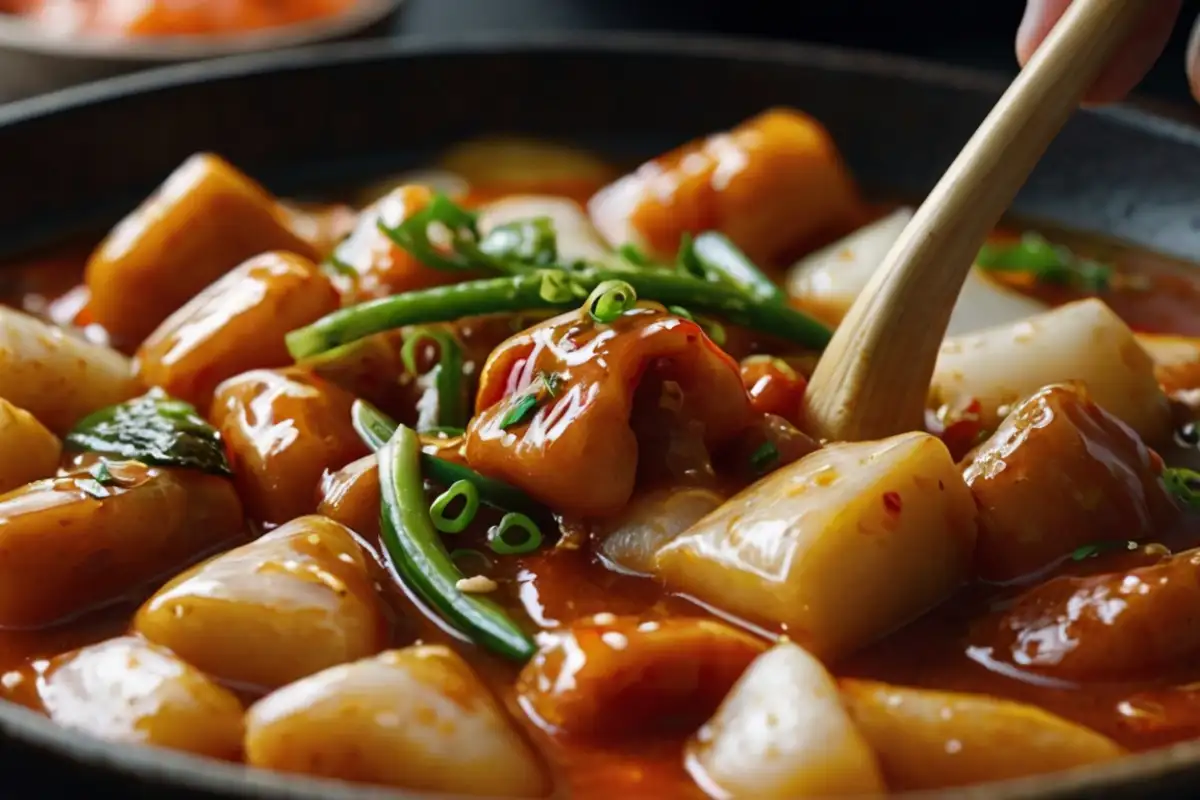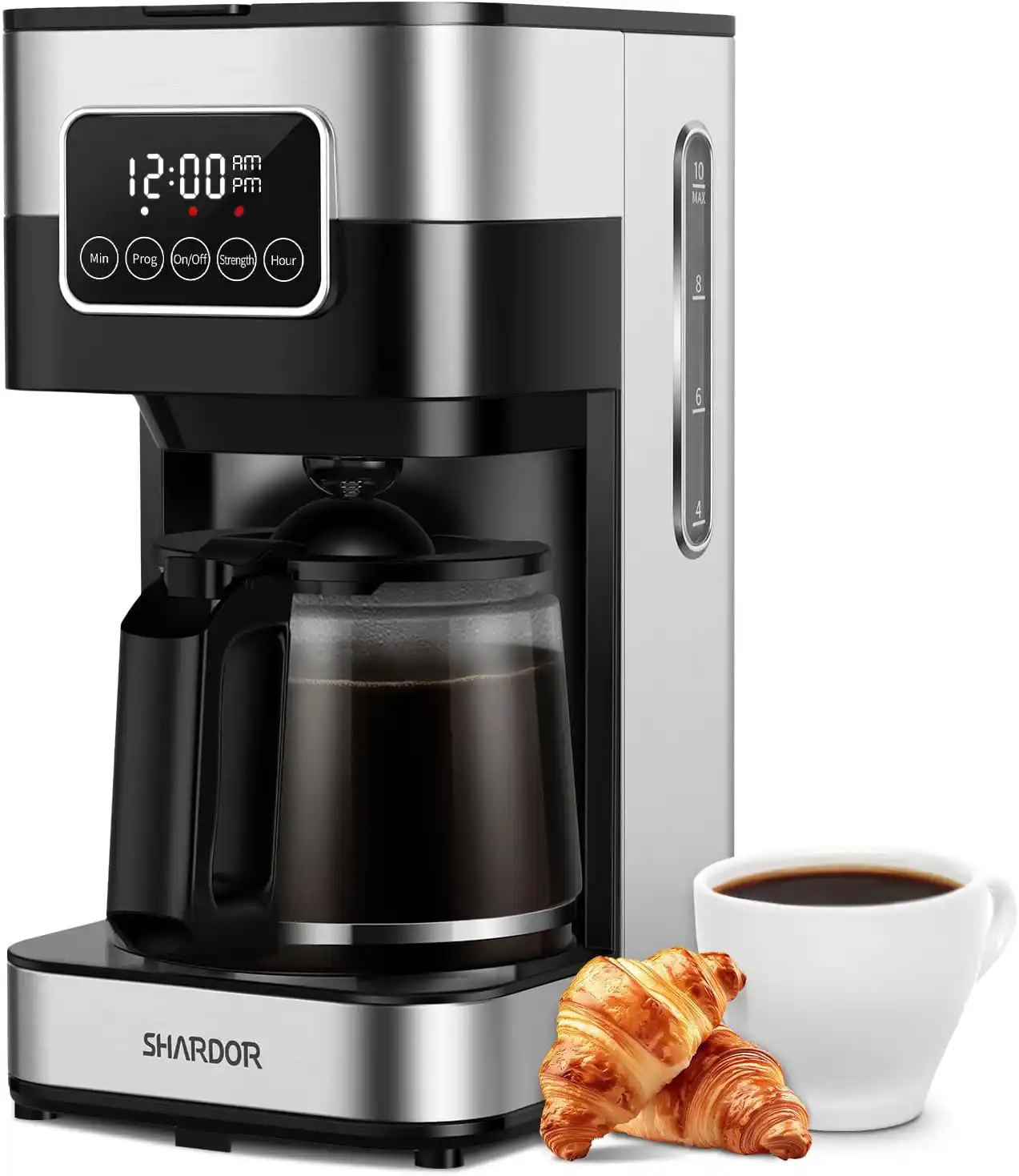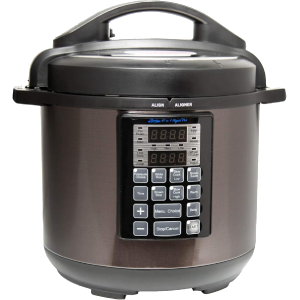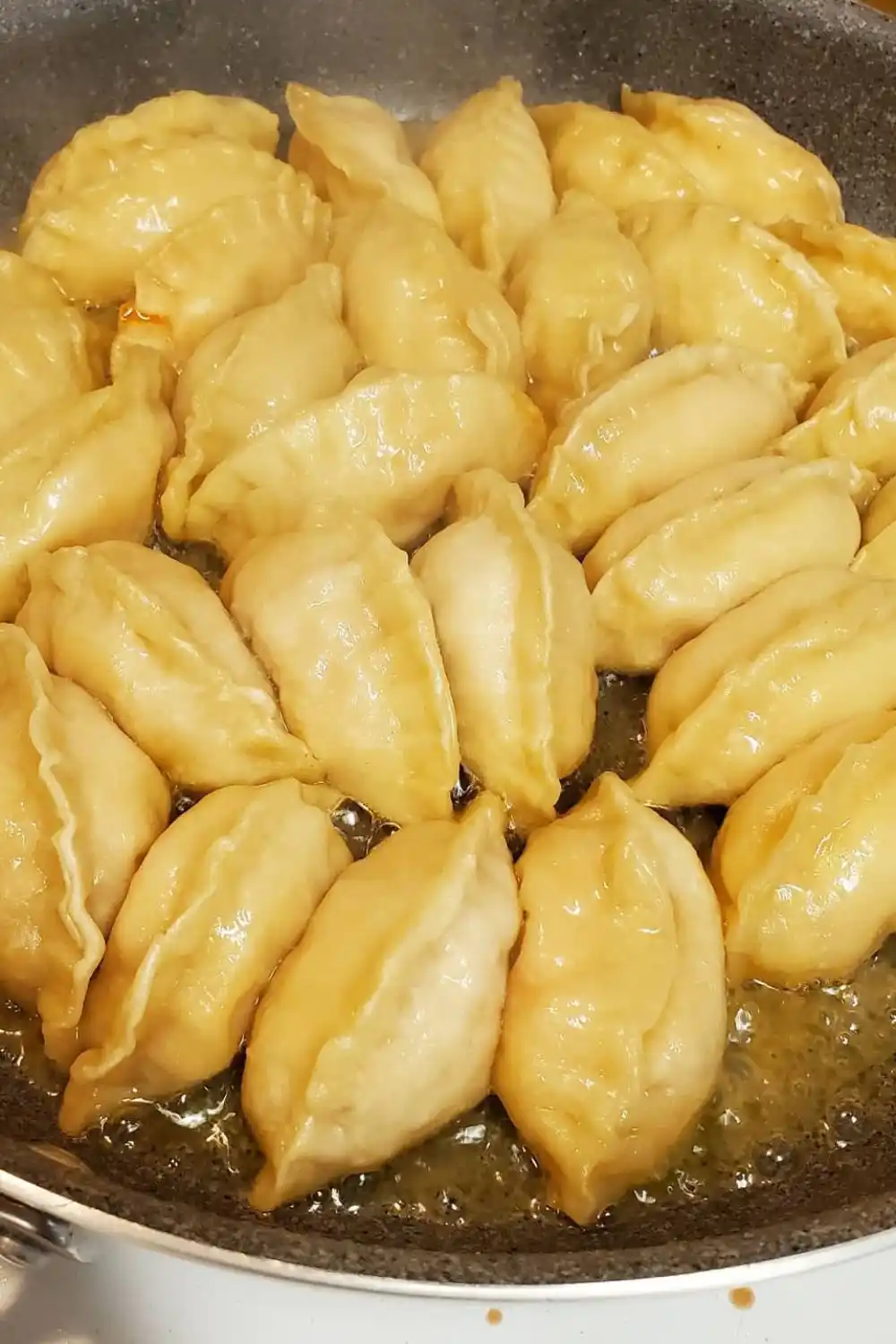If you’ve ever craved a spicy, savory, and chewy dish that embodies the essence of Korean street food, then this tteokbokki recipe is exactly what you need. Tteokbokki, also known as spicy Korean rice cakes, is a popular dish in Korea that has captured the hearts of food lovers worldwide. This dish is rich in flavor, packed with a satisfying chewiness from the rice cakes, and coated in a delectable spicy sauce that makes it an unforgettable experience. Whether you’re new to Korean cuisine or a seasoned aficionado, this guide will walk you through everything you need to know to create the perfect tteokbokki at home.
What is Tteokbokki?
Tteokbokki is a beloved Korean dish made primarily of tteok, cylindrical rice cakes, and a spicy gochujang-based sauce. Originating from royal court cuisine, where it was initially served as a mild soy sauce-based dish known as gungjung tteokbokki, the modern version has evolved to include a fiery red pepper paste that gives it its signature heat and color.
The rice cakes used in tteokbokki are called garaetteok, which are thick and chewy, providing the perfect texture to absorb the spicy sauce. Other common ingredients include fish cakes (eomuk), boiled eggs, and scallions, which add layers of flavor and texture to the dish. Tteokbokki is often enjoyed as a snack, street food, or as part of a meal, and it pairs wonderfully with a variety of side dishes.
A Brief History of Tteokbokki
Tteokbokki’s history dates back to the Joseon Dynasty, where it was initially known as tteok jjim, a savory dish served to the royal family. The dish was made with white rice cakes, beef, and soy sauce, offering a milder flavor profile compared to today’s spicy version. It wasn’t until the 1950s, after the Korean War, that the spicy version of tteokbokki became popular. This modern variation was created by accident when a street vendor named Ma Bok-rim accidentally dropped some rice cakes into a pot of spicy red chili paste. The result was so delicious that it quickly became a hit, and tteokbokki as we know it today was born.
Why This Tteokbokki Recipe is a Must-Try ?
This tteokbokki recipe is designed to bring the authentic flavors of Korean street food right into your kitchen. It’s a perfect balance of spicy, sweet, and savory, making it a dish that you won’t be able to resist. Not only does it capture the traditional flavors, but it also offers flexibility in ingredients, allowing you to customize it according to your taste. Whether you prefer your tteokbokki extra spicy, with more vegetables, or even with a hint of sweetness, this recipe can be adapted to suit your preferences.

Ingredients for the Perfect Tteokbokki recipe
The ingredients you choose for your tteokbokki can make or break the dish. Here’s a breakdown of what you’ll need:
Core Ingredients:
- Rice Cakes (Tteok):
- Garaetteok is the main ingredient in tteokbokki. These cylindrical rice cakes are chewy and perfect for absorbing the spicy sauce. Fresh or frozen rice cakes can be used, but if using frozen, be sure to soak them in warm water to soften them before cooking.
- Gochujang (Korean Red Chili Paste):
- Gochujang is essential for giving tteokbokki its signature heat and color. This fermented chili paste is made from chili powder, glutinous rice, and fermented soybeans, and it brings a deep, complex flavor to the dish.
- Gochugaru (Korean Chili Flakes):
- For an extra kick, gochugaru adds another layer of heat to the tteokbokki. You can adjust the amount depending on your spice tolerance.
- Soy Sauce:
- Soy sauce adds a salty, umami depth to the sauce, balancing the sweetness of the gochujang.
- Sugar:
- A bit of sugar helps to balance out the spiciness and adds a subtle sweetness to the dish.
- Fish Cakes (Eomuk):
- Fish cakes are a traditional addition to tteokbokki, providing a slightly chewy texture and a savory flavor that complements the rice cakes.
- Boiled Eggs:
- Hard-boiled eggs are often added to tteokbokki, soaking up the spicy sauce and adding richness to the dish.
- Scallions:
- Scallions provide a fresh, sharp contrast to the rich sauce and add a bit of color to the dish.
Optional Ingredients:
- Cabbage:
- Adding cabbage gives the dish extra texture and a slight sweetness that contrasts with the spicy sauce.
- Mushrooms:
- Mushrooms can add a meaty texture and absorb the flavors of the sauce well. Shiitake or button mushrooms work particularly well.
- Cheese:
- Some variations of tteokbokki include cheese, which melts into the sauce, adding creaminess and toning down the spice.
Ingredient Sourcing Tips
When making tteokbokki, using fresh ingredients is key to achieving the best flavor. Here are some tips for sourcing your ingredients:
- Rice Cakes: You can find fresh or frozen tteok in Korean grocery stores or online. If you’re buying frozen, make sure to check the expiration date and avoid any packages with freezer burn.
- Gochujang and Gochugaru: These can be found in most Asian grocery stores, or even in the international section of larger supermarkets. When choosing gochujang, look for one that has no added preservatives or artificial colors for the most authentic flavor.
- Fish Cakes: Fresh fish cakes are best, but frozen or vacuum-packed versions can also work well. Look for fish cakes that are firm to the touch and have a clean, fresh smell.
More Related Recipes
If you are a fan of Tteokbokki recipe, you will definitely love these recipes :

How to Make Tteokbokki recipe ? Step-by-Step Instructions
Step 1: Preparing the Ingredients
Start by preparing all your ingredients. If you’re using frozen rice cakes, soak them in warm water for about 10-15 minutes to soften them. Slice the fish cakes into bite-sized pieces, chop the scallions, and if you’re using any vegetables like cabbage or mushrooms, prepare them as well.
Step 2: Making the Sauce
In a large pan or wok, combine 3 tablespoons of gochujang, 1 tablespoon of gochugaru, 1 tablespoon of soy sauce, 1 tablespoon of sugar, and 2 cups of water. Stir the ingredients together until the gochujang and sugar are fully dissolved, creating a smooth, spicy sauce.
Step 3: Cooking the Tteokbokki
Add the soaked rice cakes to the pan with the sauce. Bring the mixture to a boil over medium-high heat, stirring occasionally to prevent the rice cakes from sticking to the bottom of the pan. Cook for about 8-10 minutes, or until the rice cakes become soft and chewy, and the sauce has thickened.
Step 4: Adding Additional Ingredients
Once the rice cakes are almost done, add the sliced fish cakes, boiled eggs, and any additional vegetables you’re using. Continue to simmer the mixture for another 5-7 minutes, allowing all the ingredients to absorb the flavors of the sauce. If you’re adding cheese, sprinkle it over the top during the last minute of cooking and let it melt into the sauce.
Step 5: Final Touches
Before serving, garnish your tteokbokki with chopped scallions and sesame seeds for a bit of crunch and freshness. Serve hot and enjoy your homemade tteokbokki!
Tteokbokki Variations to Try
One of the best things about tteokbokki recipe is its versatility. Here are a few popular variations you might want to try:
1. Cheese Tteokbokki:
- Adding cheese to tteokbokki is a popular variation that adds a creamy richness to the dish. Simply sprinkle shredded mozzarella cheese over the cooked tteokbokki and let it melt before serving.
2. Cream Tteokbokki:
- For a milder version, cream tteokbokki uses a combination of milk and cream instead of water in the sauce. This creates a luxurious, creamy dish that’s perfect for those who prefer a less spicy option.
3. Rose Tteokbokki:
- A fusion between traditional tteokbokki and Italian pasta, rose tteokbokki includes a tomato-based sauce along with the gochujang, creating a unique and flavorful dish.
4. Seafood Tteokbokki:
- Adding shrimp, squid, or other seafood to your tteokbokki gives it a briny, oceanic flavor that pairs beautifully with the spicy sauce.
The Cultural Significance of Tteokbokki
Tteokbokki is more than just a delicious dish; it’s a significant part of Korean culture. In Korea, tteokbokki is a popular street food, often sold by vendors in bustling markets and busy city streets. It’s a comfort food for many Koreans, evoking memories of childhood and the warm, spicy flavors of home.
Tteokbokki is also a dish that brings people together. In Korea, it’s common to see groups of friends gathered around a steaming plate of tteokbokki, enjoying the food and each other’s company. The dish’s communal nature, with its large portions and bold flavors, makes it perfect for sharing.
Tteokbokki in Modern Korean Cuisine
In recent years, tteokbokki has gained international popularity, with Korean restaurants around the world offering their take on this traditional dish. The rise of Korean pop culture, including K-pop and Korean dramas, has also played a role in introducing tteokbokki to a global audience. Today, you can find tteokbokki in many major cities worldwide, often with unique twists that reflect the local culinary influences.
Pairing Tteokbokki with Other Dishes
While tteokbokki is a complete dish on its own, it pairs wonderfully with a variety of other Korean dishes. Here are some pairing suggestions to enhance your tteokbokki meal:
1. Kimchi:
- The tangy, fermented flavors of kimchi complement the spicy and sweet notes of tteokbokki. The crunch of kimchi also adds a refreshing contrast to the chewy rice cakes.
2. Kimbap:
- Kimbap, or Korean sushi rolls, make a great side dish for tteokbokki. The savory flavors of kimbap balance out the heat of the tteokbokki, and the combination of textures is delightful.
3. Korean Fried Chicken:
- For those who enjoy a heartier meal, pairing tteokbokki with crispy Korean fried chicken is a match made in heaven. The crunchy chicken contrasts with the chewy rice cakes, while the sweet and spicy sauces complement each other perfectly.
4. Soju or Makgeolli:
- No Korean meal is complete without a traditional drink. Soju, a Korean distilled liquor, or Makgeolli, a milky rice wine, both pair excellently with the bold flavors of tteokbokki.

Health and Nutritional Insights
Tteokbokki, while delicious, is often seen as a treat rather than an everyday meal due to its high carbohydrate and calorie content. However, there are ways to make tteokbokki a bit healthier if you’re looking to enjoy it more frequently.
Healthier Ingredient Alternatives
- Whole Grain Rice Cakes:
- Substitute the traditional white rice cakes with whole grain or brown rice cakes. These offer more fiber and nutrients while still providing that chewy texture.
- Reduced Sugar:
- You can reduce the amount of sugar in the sauce or substitute it with a natural sweetener like honey or stevia.
- Add More Vegetables:
- By increasing the amount of vegetables in your tteokbokki, you add more fiber, vitamins, and minerals to the dish. Vegetables like carrots, bell peppers, and spinach work well.
- Lean Protein:
- Instead of fish cakes, try adding lean protein sources like grilled chicken or tofu. This can help make the dish more balanced and filling.
Nutritional Breakdown
On average, a serving of tteokbokki (about 300 grams) contains approximately:
- Calories: 300-400 kcal
- Carbohydrates: 60-80 grams
- Protein: 5-10 grams
- Fat: 5-10 grams
- Fiber: 2-4 grams
While tteokbokki is relatively high in carbohydrates, it’s low in fat and can be a good source of energy. If you’re mindful of portion sizes and choose healthier variations, tteokbokki can fit into a balanced diet.
Tteokbokki is more than just a spicy dish; it’s a representation of Korean culture and cuisine, beloved by people of all ages. Whether you’re making it for the first time or looking to perfect your recipe, this guide provides everything you need to create a delicious and authentic tteokbokki. With its bold flavors, satisfying texture, and versatility, tteokbokki is sure to become a favorite in your culinary repertoire.
FAQs About Tteokbokki recipe
Yes, you can make tteokbokki without gochujang, though the flavor will be different. If you prefer a milder dish, you can use soy sauce and a bit of sugar to create a savory sauce. For a non-spicy alternative, consider using soy sauce, garlic, and sesame oil for flavor.
To reduce the spiciness of tteokbokki, you can use less gochujang and gochugaru in the sauce. Additionally, adding more sugar or a splash of milk can help to balance out the heat. You can also serve tteokbokki with cheese, which adds creaminess and helps to mellow the spice.
If you don’t have fish cakes or prefer not to use them, you can substitute with other protein options like tofu, chicken, or even seafood such as shrimp or squid. These alternatives will add a different flavor and texture to the dish but will still be delicious.
Leftover tteokbokki can be stored in an airtight container in the refrigerator for up to 2-3 days. When reheating, you may need to add a bit of water or broth to loosen the sauce, as it tends to thicken in the fridge. Reheat the tteokbokki on the stovetop over medium heat until it’s warmed through.
While you can freeze tteokbokki, it’s not recommended as the rice cakes may become hard and lose their chewy texture when thawed. If you do choose to freeze it, make sure to thaw it in the refrigerator overnight and reheat gently on the stove.

Tteokbokki Recipe A Step-by-Step Guide
- Total Time: Approximately 35 minutes
Description
Tteokbokki, also known as spicy Korean rice cakes, is a beloved Korean street food that combines chewy rice cakes with a flavorful, spicy sauce. This dish offers a harmonious blend of spicy, sweet, and savory flavors, making it a favorite among many.
Ingredients
Core Ingredients:
- Rice Cakes (Tteok): Cylindrical rice cakes, fresh or frozen. If using frozen, soak them in warm water to soften before cooking.
- Gochujang (Korean Red Chili Paste): Provides the signature heat and color.
- Gochugaru (Korean Chili Flakes): Adds an extra layer of spiciness; adjust to taste.
- Soy Sauce: Adds salty, umami depth to the sauce.
- Sugar: Balances the spiciness with a subtle sweetness.
- Fish Cakes (Eomuk): Sliced into bite-sized pieces; offers a chewy texture and savory flavor.
- Boiled Eggs: Hard-boiled; they absorb the spicy sauce and add richness.
- Scallions: Chopped; provide a fresh, sharp contrast to the rich sauce.
Optional Ingredients:
- Cabbage: Adds extra texture and a slight sweetness.
- Mushrooms: Shiitake or button mushrooms add a meaty texture and absorb the sauce well.
- Cheese: Melts into the sauce, adding creaminess and toning down the spice.
Instructions
Prepare the Ingredients:
- If using frozen rice cakes, soak them in warm water for about 10-15 minutes to soften.
- Slice the fish cakes into bite-sized pieces.
- Chop the scallions and any additional vegetables you’re using.
Make the Sauce:
- In a large pan, combine gochujang, gochugaru, soy sauce, sugar, and water. Stir until the mixture is well combined and smooth.
Cook the Rice Cakes:
- Add the soaked rice cakes to the pan with the sauce.
- Bring the mixture to a boil over medium-high heat, stirring occasionally to prevent sticking.
- Cook for about 8-10 minutes, or until the rice cakes become soft and chewy, and the sauce has thickened.
Add Additional Ingredients:
- Once the rice cakes are almost done, add the sliced fish cakes, boiled eggs, and any additional vegetables.
- Continue to simmer for another 5-7 minutes, allowing all ingredients to absorb the flavors of the sauce.
- If adding cheese, sprinkle it over the top during the last minute of cooking and let it melt into the sauce.
Serve:
- Garnish with chopped scallions and sesame seeds for added flavor and presentation.
- Serve hot and enjoy your homemade tteokbokki!
- Prep Time: Approximately 15 minutes
- Cook Time: Approximately 20 minutes
- Category: Dinner
- Cuisine: Korean
Keywords: Tteokbokki Recipe












